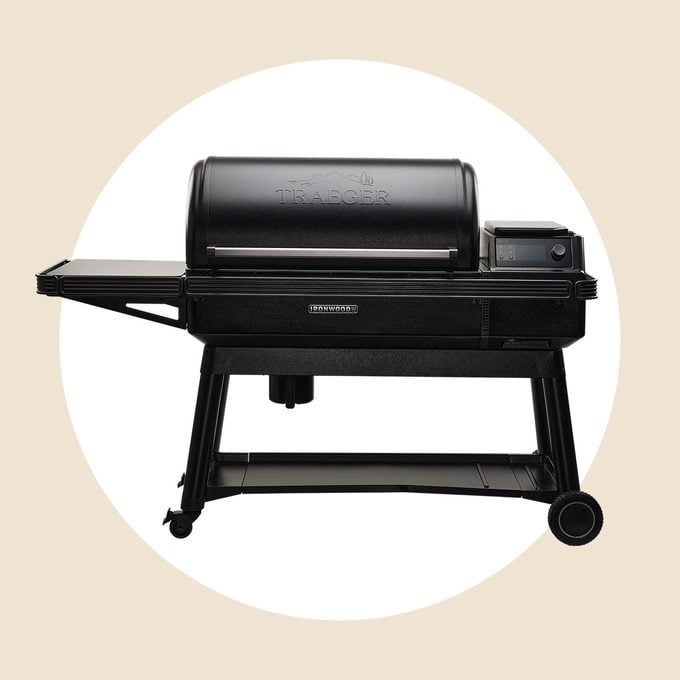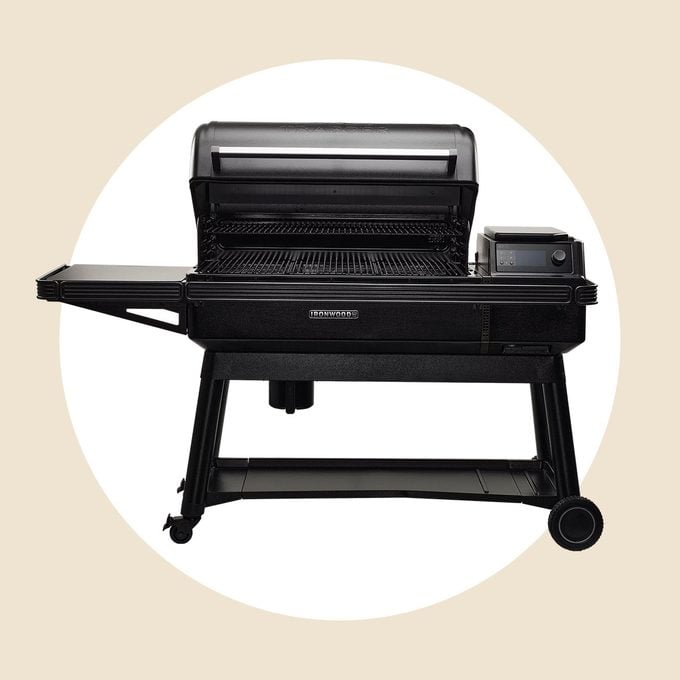Traeger Ironwood XL Review: We Tried the Pellet Grill and It Smokes Competitors
Updated: Jul. 11, 2023

Consider this your (smoke) signal to buy a pellet grill! The Traeger Ironwood XL delivered meatloaf, pork shoulder and chicken tenders with mouthwatering results.
Our editors and experts handpick every product we feature. We may earn a commission from your purchases.
I grew up in a big family—I’m one of eight kids. So at just about any given moment, you could find something cooking away on the stove, in the oven or over the grill.
The grill, in particular, was always manned by, well, the men in my family, while I stood watch over my trusty Dutch oven in the kitchen. But my curiosity was piqued by the culinary goings-on in the backyard. And I was determined to earn my spot in the pit.
I’ve come a long way since then and consider myself pretty savvy when it comes to all things grilling and even smoking. For years, I’ve been faithful to my Weber charcoal grill (and its accessories), which I convert to a smoker via the snake method and some charcoal briquettes. But I figured it was time I try my hand at using a real-deal, top-of-the-line smoker. Enter: the Traeger Ironwood XL.

What is the Traeger Ironwood XL?
The Traeger Ironwood XL is a pellet grill (a type of smoker) that runs on hardwood pellets, unlike charcoal or gas grills. It’s intended to provide a more well-rounded outdoor cooking experience than your standard grill and infuses deep smoky flavor into meats and more. According to the Traeger website, this behemoth can smoke, grill, bake, roast, braise and barbecue.
And we’re not exaggerating when we say behemoth. This pellet grill weighs 243 pounds, measures 4 feet tall and nearly 6 feet across, and boasts 924 square inches of cooking surface (rivaled only by the Blackstone Griddle). But along with this bulkiness comes a lot of deft technology, including a touchscreen, a Super Smoke mode, WiFi connectivity and sensors. Plus, it holds 22 pounds of pellets at a time and can reach 500 degrees.
Traeger Ironwood XL Features
The Traeger Ironwood XL includes tools and accessories typical of many quality grills, such as a grilling light, adjustable porcelain grates, storage shelves, a work surface and full insulation. But its offerings don’t stop there; in fact, they only get more high-tech.
Touchscreen
I think we’re all rightfully a little skeptical of touchscreens, especially on outdoor appliances. Who among us hasn’t wrestled with a particularly insensitive one? Thankfully, the sizable, full-color digital display included on the Traeger Ironwood XL works beautifully and is super intuitive to use. I love that it continuously displays the interior temperature of the grill. Because of this feature, however, the grill does require an outlet, so make sure you have outdoor power before splurging.
WiFi Connectivity
Yes, the Ironwood XL connects to the internet—a feature the Traeger team cleverly calls “WiFire Connectivity.” Users can link their phone and grill through an app. With this app, they’re able to adjust the smoker’s internal temperature and gauge food’s doneness.
Pellet Sensor
The aforementioned hardwood pellets go into a hopper on the right side of the grill, where they burn and produce the necessary smoke. The pellet sensor is designed to notify the user when the grill is low on pellets and needs to be refilled; this means you’ll never run out of fuel mid-smoke.
Super Smoke Mode
The Super Smoke mode works under 225 degrees, so the meat cooks lower and slower—and smokier. This function introduces a heavier concentration of smoke, imparting the desired smoky flavor to the highest degree and ultimately providing a better bark (i.e., the crust of black char on the outside of the meat).
Meat Probe
We’re big into meat thermometers at Taste of Home HQ (here’s our favorite!). The Traeger Ironwood XL comes with two probes, which is handy if you’re making two types of meat at once. I put my full faith in these Traeger probes, and their readings were quick and seemingly accurate.
Grease and Ash Bucket
The built-in grease and ash bucket successfully collects the dregs from each smoking session, making for easy cleanup. Before cooking, be sure to line the bucket with one of the branded foil liners. There are only a couple of liners included with the smoker, so you’ll need to restock after a while. Thankfully, this shouldn’t be too often, though. After I smoked seven types of meat, grease only filled about a quarter of the bucket.
How We Tested It
Assembling
The setup of the Ironwood XL took about five hours; I’d consider it a full afternoon project, which makes sense given its size. The easy-to-follow instructions suggest two people build the smoker together and share a six-pack along the way—I concur!
The pellet grill comes with a screwdriver and a wrench, but I’d recommend using your own if you have them. The wrench, especially, is a little weak. It’ll get the job done, but you’d be better off with your own 1/2-inch and 3/8-inch wrenches.
The biggest snag, though, is that the team couldn’t get the WiFi to work. I tested the Ironwood XL at our Taste of Home office, which is equipped with 5GHz WiFi, and the smoker only works with 2.4GHz WiFi. (This shouldn’t be an issue for people looking to use the smoker at home.) But even without the WiFi functionality, I was wowed by the gadget and able to smoke with great success.
Once basic setup was over and done with, I seasoned the smoker. This took about an hour and entailed plugging in the grill, filling the hopper with pellets, turning on the grill, priming the auger, preheating the grill to 350 degrees and letting it run for 20 minutes. Then repeat those last two steps—but at 450 degrees for 30 minutes. This whole process is outlined thoroughly and clearly in the user manual.
Smoking
I got straight to smoking as soon as I was done seasoning, using things I had on hand, including applewood for the pellets and chicken tenders, ground beef and pork, and pork loin roast for the meat. The chicken tenders, which took 40 minutes to smoke, and the pork roast, which took two hours, got the Traeger treatment with the brand’s honey-apple rub. And I turned the ground meats into a smoked meatloaf that cooked for two hours. Each item was smoky, moist and undeniably delicious.
I chose to remove the upper grate while cooking because I wanted plenty of room to access the meats from all sides, but that upper grate is an awesome bonus space that could handily hold corn, veggies or salmon fillets. (Psst! Have you ever grilled salmon on a salt block?)
Now, on to the main event: the pork shoulders. I cooked five in total. I smoked the first at 275 degrees and found that, when all was said and done, the bark wasn’t as dark or as crisp as the bark my Weber grill produces. The smoky flavor also wasn’t as prominent. At this point, I turned to Super Smoke mode.
The two pork shoulders I smoked with this special mode cooked at 225 degrees, and let’s just say, the name is fitting. The Super Smoke mode noticeably enhanced the smoke flavor and delivered a darker bark. But because the shoulders were smoking at a lower temperature, they did take longer to cook through.
Determined to conquer the Ironwood XL, sans Super Smoke mode, I cooked two more pork shoulders at 275 degrees, but this time, I wrapped them in foil only once the thickest part of the meat had reached 190 degrees (I usually take this step when the meat is between 170 degrees and 180 degrees). This decision gave the bark more time to develop into a beautiful dark mahogany crust with a 1/2-inch smoke ring. The sweet, smoky applewood flavor was present throughout the whole shoulder. Nailed it! Now, if only I’d had this personalized branding iron for meat…
Cleaning
The grill cools down quickly, so you can get right to cleaning. No special cleaning liquids or implements come with the smoker, but Traeger does sell its own branded cleaner separately. However, I found any ol’ soap will do the trick.
I lifted the racks out of the smoker and soaked them in the sink with hot, soapy water. After a few minutes, a stiff plastic bristle brush was able to remove the stuck-on bits with ease. (We also love this bristle-free brush for cleaning grills!)
As for the liner (the base of the interior of the smoker), cleaning this part’s a bit trickier. There are no disposable drip trays compatible with the Ironwood XL, which would’ve made cleanup a cinch. (Here’s hoping those are in the works over at Traeger!) So, washing the liner took a bit of elbow grease in order to remove all the splatters and food particles. Afterward, the liner had a bronze tint to it, which doesn’t bother me, but it certainly didn’t look brand new, even after just one use.
And as stated above, the grease and ash bucket does a stand-up job collecting all it claims to. The foil bucket liner needn’t be changed after each use, but keep an eye on it, then toss it in the trash when it’s full.
Pros
- Generously sized cooking surface
- Advanced, accurate technology
- Beginner-friendly
- Easy to clean
- Produces substantial smoky flavor, especially with Super Smoke mode
Cons
- High price tag
- Large footprint
- Two-person, lengthy setup
- No disposable liners available for this model
FAQ
How long does a 20-lb. bag of pellets last in a Traeger grill?
A 20-pound bag of wood pellets can last for up to 20 hours of cook time, depending on the temperature of the grill and how often you use it. In short, you should be able to get in a handful of lengthy smoking seshes before the hopper needs refilling. (This is why the pellet sensor is so handy!)
Can you leave pellets in Traeger overnight?
If the weather is dry, yes, you can leave pellets in your Traeger overnight and even for a few days. For wet weather or more extended periods of time, remove the pellets from the hopper and store them in an airtight container.
What Other Reviewers Had to Say
The grandeur of the Traeger Ironwood XL is not all smoke (and mirrors), and other satisfied customers say so too!
Reviewer Nick F. was new to the hobby before purchasing his smoker. In fact, he’d never even used one. No big deal! “In the few weeks since I received and began using my Traeger Ironwood XL, I have successfully smoked chickens, ribs and, of course, brisket,” he says. “This grill has so many features that with a little practice, you can produce expert results. I love it.”
AJ L., on the other hand, is an experienced smoker but still equally impressed: “It has the most smoky flavor that I’ve had to date off a pellet grill, even without the use of Super Smoke. I’ve had the Ironwood XL for a couple of months now, and I use it two-three times a week.”
Beyond its actual smoking capabilities, other users were most excited about the technology of it all. “I just got this last Tuesday,” Andy U. says. “Let’s just say it’s a work of art. The technology is awesome! I had one question and went to Traeger Chat, and within five minutes, my problem was resolved.”
Product Comparison
The Traeger Ironwood XL is the first pellet grill I’ve tried, and I was blown away. And this is unsurprising; the internet is quick to confirm that Traeger is the best in its class.
When comparing the standard Ironwood to the Ironwood XL, the latter is about 45 pounds heavier and contains 308 square inches more cooking space. The two models are the same height, but the XL is nearly a foot longer. Notably, the XL is only $200 more, which gets you a lot more bang for your buck, in my opinion. It’s any griller’s dream gift.
Final Verdict
If you’re serious about smoking, don’t be put off by the imposing footprint. The Ironwood XL creates shockingly little mess, so it can go on a patio, deck or even grass. If you want this stunner, you’ll find the space for it! As for those just starting out with this smoky pastime, the Traeger XL is great for you, too, albeit a splurge. It’s intuitive and multi-functional, and it doesn’t require, what I like to call, “babysitting.”
The generously sized cooking surfaces accommodate all my personal and entertaining needs, and I’m so excited to use the grill all summer and into the fall. That trademark smoky flavor is one of my all-time favorite things, and the Traeger Ironwood XL is a surefire way to savor it how and when I want.
Where to Buy the Traeger Ironwood XL
Score yourself a Traeger Ironwood XL on the company’s website or from Williams Sonoma, Home Depot or Amazon for about $1999. This pellet grill is all dark bark and tasty bites!

